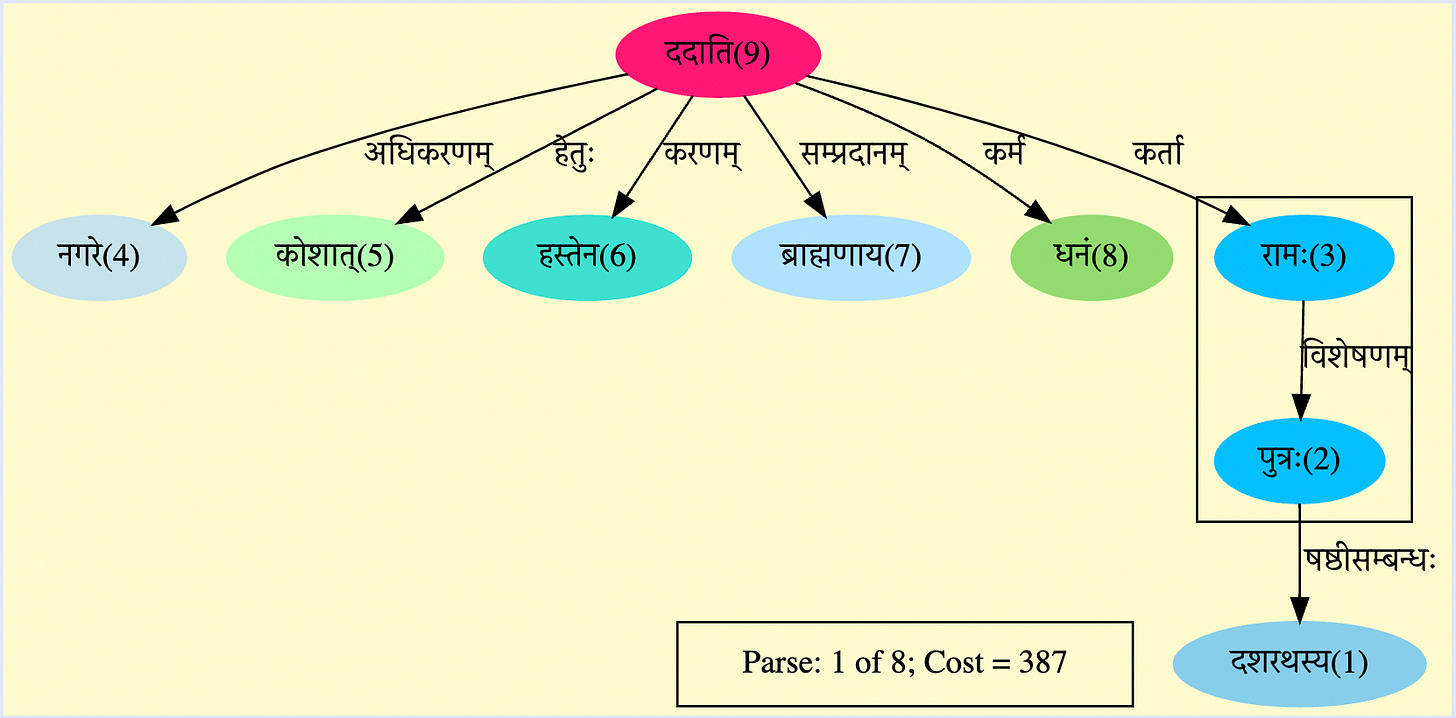Sanskrit Noun Declensions from the Verb Perspective
Noun Declensions make a lot more sense when we add a verb to them...
When I was first starting to wrap my head around Sanskrit Noun Declensions I wrote this blog post attempting to explain it. I learned A LOT since then, but just recently I was introduced to a slightly different way to approach how to think about Noun Declensions from this paper and the अनुसारकम् tool on the Samsadhani website, which I want to share here.
Let’s take the example sentence from the अनुसारकम् tool, which has every Vibhakti (or Noun Declension) included in it:
दशरथस्य पुत्रः रामः नगरे कोशात् हस्तेन ब्राह्मणाय धनं ददाति
daśarathasya putraḥ rāmaḥ nagare kośāt hastena brāhmaṇāya dhanaṃ dadāti
Translation: Daśaratha’s son Rama gives money to Brahmans with his hands from the treasury in the city
Now - instead of looking at each noun, what if we reverse it and look at the sentence from the perspective of the verb?!! Then the declension table takes on a much more meaningful role.
In this case, the verb is ददाति (dadāti), which means gives. Giving is the action or कर्म of this sentence. So now we start asking questions:
Who gives?
The कर्तृ (doer) gives.
In this case, the कर्तृ is राम
राम takes on the प्रथमा विभक्तिः (Nominative Case) - रामः
What is the object of the action of giving?
The कर्म्मन् or object of the कर्म (action of giving) is धन (money)
धन takes on the द्वितीया विभक्तिः (Accusative Case) - धनम्
What is the instrument used for the giving?
The करण, the instrument or means of action, are the हस्त (hands)
हस्त takes on the तृतीया विभक्तिः (Instrumental Case) - हस्तेन
Who is the receiver of the giving?
The ब्राह्मण are the receivers of the सम्प्रदान or gift of the action
ब्राह्मण takes on the चतुर्थी विभक्तिः (Dative Case) - ब्राह्मणाय
From what / whom is the act of giving taking away?
The कर्म of giving means that something is first taken from something or someone (अपादान) before it is given to someone else (सम्प्रदान).
In this case, the act of giving money to the Brahmans means the money is being taken away from the treasury or कोश.
कोश takes on the पञ्चमी विभक्तिः (Ablative Case) - कोशात्
Where is the location of the कर्म taking place?
The location or the अधिकरण is the city or नगर
नगर takes on the सप्तमी विभक्तिः (Locative Case) - नगरे
Now, there are still two words left in the sentence that are not included in the questions above - दशरथस्य पुत्रः. That is because these are in relation to the noun, in this case, रामः, and not to the कर्म or action of giving (ददाति).
They can therefore be categorized as follows:
पुत्र is a विशेषण or adjective of the word राम. The विशेषण gets the same विभक्ति as the object it is describing, in this case, it’ll follow प्रथमा विभक्तिः to match the case of राम - पुत्रः रामः
दशरथ is mentioned to show the relationship or सम्बन्धः between राम and दशरथ. Rāma is Daśaratha’s son. Therefore, it gets the षष्ठी विभक्तिः (Genetive Case) - दशरथस्य.
This can be visualized beautifully in the अनुसारकम् tool:




